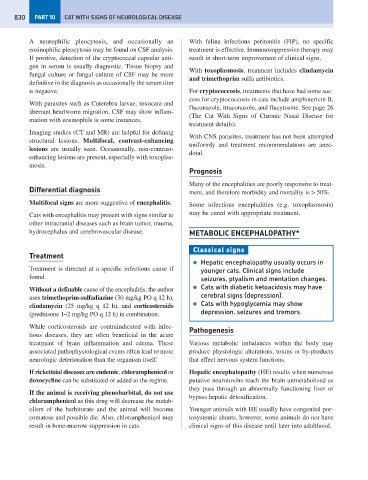Page 838 - Problem-Based Feline Medicine
P. 838
830 PART 10 CAT WITH SIGNS OF NEUROLOGICAL DISEASE
A neurophilic pleocytosis, and occasionally an With feline infectious peritonitis (FIP), no specific
eosinophilic pleocytosis may be found on CSF analysis. treatment is effective. Immunosuppressive therapy may
If positive, detection of the cryptococcal capsular anti- result in short-term improvement of clinical signs.
gen in serum is usually diagnostic. Tissue biopsy and
With toxoplasmosis, treatment includes clindamycin
fungal culture or fungal culture of CSF may be more
and trimethoprim sulfa antibiotics.
definitive in the diagnosis as occasionally the serum titer
is negative. For cryptococcosis, treatments that have had some suc-
cess for cryptococcosis in cats include amphotericin B,
With parasites such as Cuterebra larvae, toxocara and
fluconazole, itraconazole, and flucytosine. See page 26
aberrant heartworm migration, CSF may show inflam-
(The Cat With Signs of Chronic Nasal Disease for
mation with eosinophils is some instances.
treatment details).
Imaging studies (CT and MR) are helpful for defining
With CNS parasites, treatment has not been attempted
structural lesions. Multifocal, contrast-enhancing
uniformly and treatment recommendations are anec-
lesions are usually seen. Occasionally, non-contrast-
dotal.
enhancing lesions are present, especially with toxoplas-
mosis.
Prognosis
Many of the encephalities are poorly responsive to treat-
Differential diagnosis ment, and therefore morbidity and mortality is > 50%.
Multifocal signs are more suggestive of encephalitis. Some infectious encephalities (e.g. toxoplasmosis)
Cats with encephalitis may present with signs similar to may be cured with appropriate treatment.
other intracranial diseases such as brain tumor, trauma,
hydrocephalus and cerebrovascular disease. METABOLIC ENCEPHALOPATHY*
Classical signs
Treatment
● Hepatic encephalopathy usually occurs in
Treatment is directed at a specific infectious cause if younger cats. Clinical signs include
found. seizures, ptyalism and mentation changes.
● Cats with diabetic ketoacidosis may have
Without a definable cause of the encephalitis, the author
cerebral signs (depression).
uses trimethoprim-sulfadiazine (30 mg/kg PO q 12 h),
● Cats with hypoglycemia may show
clindamycin (25 mg/kg q 12 h), and corticosteroids
depression, seizures and tremors.
(prednisone 1–2 mg/kg PO q 12 h) in combination.
While corticosteroids are contraindicated with infec-
Pathogenesis
tious diseases, they are often beneficial in the acute
treatment of brain inflammation and edema. These Various metabolic imbalances within the body may
associated pathophysiological events often lead to more produce physiologic alterations, toxins or by-products
neurologic deterioration than the organism itself. that effect nervous system functions.
If rickettsial diseases are endemic, chloramphenicol or Hepatic encephalopathy (HE) results when numerous
doxocycline can be substituted or added to the regime. putative neurotoxins reach the brain unmetabolized as
they pass through an abnormally functioning liver or
If the animal is receiving phenobarbital, do not use
bypass hepatic detoxification.
chloramphenicol as this drug will decrease the metab-
olism of the barbiturate and the animal will become Younger animals with HE usually have congenital por-
comatose and possible die. Also, chloramphenicol may tosystemic shunts, however, some animals do not have
result in bone-marrow suppression in cats. clinical signs of this disease until later into adulthood.

